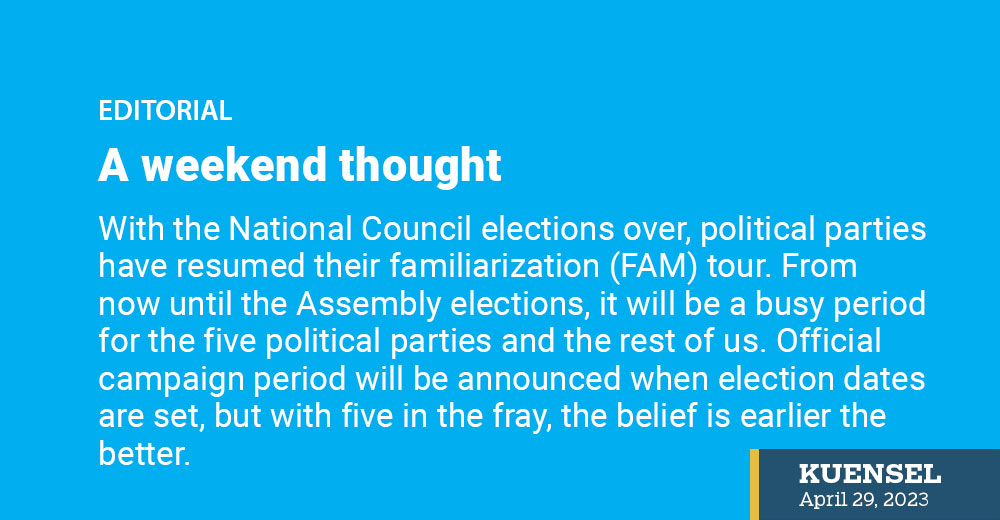With the National Council elections over, political parties have resumed their familiarization (FAM) tour. From now until the Assembly elections, it will be a busy period for the five political parties and the rest of us. Official campaign period will be announced when election dates are set, but with five in the fray, the belief is earlier the better.
Meanwhile, potential voters are also kept busy. From Trashigang in the east to Paro in the west, members of political parties are meeting and greeting people, calling them to attend FAM zomdus and listen to the new member joining to “serve the people and the country.”
It should be an exciting period for the people. They would be hearing a lot of new ideas, promises and pledges from parties that are either for a progressive modern economy based on GNH, representing the voice and hope of the people, narrowing the gap or for a vibrant democracy and for a better drukyul. To be more relevant, parties have redesigned their logo and rebranded themselves.
The election is a year away, giving time for political parties to convince the people and the voters to make up their mind. It is said that voters are still swayed by how effective party workers are or who they know. 15 years into democracy, voters should be more informed and experienced. They will question and analyse what can be done or what can be achieved.
High on the agenda, every election year, is the high cost of living. It is getting worse as the economy is trying to shed the impact of the Covid-19 pandemic. Cost of goods and services still drives inflation. Cost of transportation is the main driver of inflation.
As a land-locked country entirely dependent on importing goods on the back of trucks, the import bill of fossil fuel is higher than the export of electricity. How can we shed the dependence on diesel?
A political party who prioritises going electric, many agree, could relate to the voters. The future, it is said, lies in electric vehicles. Even as we talk, the future is already here. With a focus on decarbonizing road transport, the priority is to propel electric vehicles. In other words, going electric is a reality. For Bhutan, known as the champion of environment conservation and protection, it suits our vision.
If we can replace half the vehicles on our congested roads with electric vehicles, our dependence on fossil fuel will fall. Besides, we have the resources to drive electric vehicles. Diverting clean energy to enhance our EV policy would benefit us all. There may not be electric trucks to transport goods from Phuentsholing to Thimphu or sand from the Sha region to Thimphu, but replacing 50 percent of the vehicles on the capital city’s roads with EV would be a huge achievement, if not another feather in the cap for carbon neutral Bhutan.
For Bhutan, who always talk about our smallness, it is even easier. There need not be subsidies, but incentives like low interest rates on loans, free parking space for EVs, charging stations at the convenience of EV owners and tax waiver on profits earned from EV related businesses could promote the EV drive. Replacing 50 percent of the vehicles on our roads is not difficult. Given our smallness, we are talking about 63,000 vehicles (trucks included).
How we do it is up for discussions. Should we do it? The answer is in our import bill.


